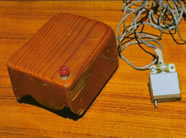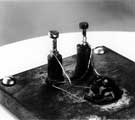 The first computer mouse was developed by Doug Englebart in 1963 at Stanford Research Institute. He had been creating the oN-Line System, or NLS, a hardware and software system that incorporated many of the concepts of today’s modern computers. Using two gear wheels at perpindicular positions, it allowed movement of the mouse on the X and Y planes of axis. Each wheel’s rotation was translated to motion on the plane. Englebart patented the “X-Y Position Indicator For A Display System” in Nov., 1970. Later Bill English devised a variation of the mouse at Xerox which used a single round ball that could move in any direction. An inverted trackball, it became the dominant form of computer mouse in the 80s and 90s. Even later the advent of the optical mouse further evolved the device again.
The first computer mouse was developed by Doug Englebart in 1963 at Stanford Research Institute. He had been creating the oN-Line System, or NLS, a hardware and software system that incorporated many of the concepts of today’s modern computers. Using two gear wheels at perpindicular positions, it allowed movement of the mouse on the X and Y planes of axis. Each wheel’s rotation was translated to motion on the plane. Englebart patented the “X-Y Position Indicator For A Display System” in Nov., 1970. Later Bill English devised a variation of the mouse at Xerox which used a single round ball that could move in any direction. An inverted trackball, it became the dominant form of computer mouse in the 80s and 90s. Even later the advent of the optical mouse further evolved the device again.
Category Archives: Inventions
Rancho Arm
 Acquired by Stanford University in 1963, the Rancho Arm, a machine that is used as a human arm, holds a place among the first artificial robotic arms to be controlled by a computer. The dream has been fulfilled for the unfortunate children and adults that have been taken hold of a terrible disease and left without an arm. Researchers at the Rancho Los Amigos Hospital in Downey, California designed the Rancho Arm as a tool for the handicapped.
Acquired by Stanford University in 1963, the Rancho Arm, a machine that is used as a human arm, holds a place among the first artificial robotic arms to be controlled by a computer. The dream has been fulfilled for the unfortunate children and adults that have been taken hold of a terrible disease and left without an arm. Researchers at the Rancho Los Amigos Hospital in Downey, California designed the Rancho Arm as a tool for the handicapped.
ASCII
 Acronym for the American Standard Code for Information Interchange. Pronounced ask-ee, ASCII is a code for representing English characters as numbers, with each letter assigned a number from 0 to 127. Most computers use ASCII codes to represent text, which makes it possible to transfer data from one computer to another.
Acronym for the American Standard Code for Information Interchange. Pronounced ask-ee, ASCII is a code for representing English characters as numbers, with each letter assigned a number from 0 to 127. Most computers use ASCII codes to represent text, which makes it possible to transfer data from one computer to another.
Text files stored in ASCII format are sometimes called ASCII files. Text editors and word processors are usually capable of storing data in ASCII format, although ASCII format is not always the default storage format. Most data files, particularly if they contain numeric data, are not stored in ASCII format. Executable programs are never stored in ASCII format.
The standard ASCII character set uses just 7 bits for each character. There are several larger character sets that use 8 bits, which gives them 128 additional characters. The extra characters are used to represent non-English characters, graphics symbols, and mathematical symbols. Several companies and organizations have proposed extensions for these 128 characters.
Virtual Memory
 What do you do when you run out of real random access memory (RAM)? Easy. Pass it off to virtual memory. To do this you need a virtual memory manager (usually a function of the operating system) that maps chunks of data and code to storage areas that aren’t RAM. Virtual memory is really a part of your hard disk called a swap file, dedicated as a storage area for bits of data in RAM that aren’t being used much. By freeing up RAM, you’re virtually increasing the amount of working memory available to you.
What do you do when you run out of real random access memory (RAM)? Easy. Pass it off to virtual memory. To do this you need a virtual memory manager (usually a function of the operating system) that maps chunks of data and code to storage areas that aren’t RAM. Virtual memory is really a part of your hard disk called a swap file, dedicated as a storage area for bits of data in RAM that aren’t being used much. By freeing up RAM, you’re virtually increasing the amount of working memory available to you.
ERMA
 In 1950 the Bank of America asked SRI to assess the possibility of developing electronic computers that could take over the labor-intensive banking tasks of handling checks and balancing accounts. The creation of branch offices and the rapidly increasing number of checks being used by a growing clientele threatened to overwhelm the existing manual processing and record keeping. At that time no large-scale electronic machine for any bank was under development. Existing computers were used mostly for scientific calculations. They were unreliable, and had extremely limited input and output capability. In spite of these facts, SRI’s feasibility study, issued in May 1951, was sufficiently encouraging for the Bank of America to authorize a major multi-year development effort.
In 1950 the Bank of America asked SRI to assess the possibility of developing electronic computers that could take over the labor-intensive banking tasks of handling checks and balancing accounts. The creation of branch offices and the rapidly increasing number of checks being used by a growing clientele threatened to overwhelm the existing manual processing and record keeping. At that time no large-scale electronic machine for any bank was under development. Existing computers were used mostly for scientific calculations. They were unreliable, and had extremely limited input and output capability. In spite of these facts, SRI’s feasibility study, issued in May 1951, was sufficiently encouraging for the Bank of America to authorize a major multi-year development effort.
The Computer Modem
 In 1958, researchers at Bell Telephone Labs invent the modem, a device that converts data from computers to the phone line and back again. This switching of digital to analog makes computer networks possible. At the time there was a desire to connect to distant computers, and the obvious choice was to use the existing phone network. The original equipment ran at a paltry 1,000 bits per second and was offered as a commercial service. During the 1960s, modem technology would move swiftly, bringing ever-increasing speeds and reliability.
In 1958, researchers at Bell Telephone Labs invent the modem, a device that converts data from computers to the phone line and back again. This switching of digital to analog makes computer networks possible. At the time there was a desire to connect to distant computers, and the obvious choice was to use the existing phone network. The original equipment ran at a paltry 1,000 bits per second and was offered as a commercial service. During the 1960s, modem technology would move swiftly, bringing ever-increasing speeds and reliability.
Kilby Integrated Circuit
 Transistors had become commonplace in everything from radios to phones to computers, and now manufacturers wanted something even better. Sure, transistors were smaller than vacuum tubes, but for some of the newest electronics, they weren’t small enough.
Transistors had become commonplace in everything from radios to phones to computers, and now manufacturers wanted something even better. Sure, transistors were smaller than vacuum tubes, but for some of the newest electronics, they weren’t small enough.
One day in late July, Jack Kilby was sitting alone at Texas Instruments. He had been hired only a couple of months earlier and so he wasn’t able to take vacation time when practically everyone else did. The halls were deserted, and he had lots of time to think. It suddenly occurred to him that all parts of a circuit, not just the transistor, could be made out of silicon. At the time, nobody was making capacitors or resistors out of semiconductors. If it could be done then the entire circuit could be built out of a single crystal — making it smaller and much easier to produce. Kilby’s boss liked the idea, and told him to get to work. By September 12, Kilby had built a working model, and on February 6, Texas Instruments filed a patent. Their first “Solid Circuit” the size of a pencil point, was shown off for the first time in March.
Regency TR-1
 Regency Electronics produced the first commercial transistor radio, the Regency TR-1, it hit the consumer market in October, 1954. It featured four germanium transistors operating on a 22.5-volt battery that provided over twenty hours of life (tube radios with batteries only lasted several hours at best-ref). Several colors were initially offered in the 3″ x 5″ x 1 1/4″ plastic case: black, ivory, mandarin red, cloud gray, mahogany and olive green. Radio collectors covet the limited number of units with swirl colors. Fashion iridescent colors were offered later and rare clear plastic cases also were made. The unit weighed eleven ounces and cost $49.95.
Regency Electronics produced the first commercial transistor radio, the Regency TR-1, it hit the consumer market in October, 1954. It featured four germanium transistors operating on a 22.5-volt battery that provided over twenty hours of life (tube radios with batteries only lasted several hours at best-ref). Several colors were initially offered in the 3″ x 5″ x 1 1/4″ plastic case: black, ivory, mandarin red, cloud gray, mahogany and olive green. Radio collectors covet the limited number of units with swirl colors. Fashion iridescent colors were offered later and rare clear plastic cases also were made. The unit weighed eleven ounces and cost $49.95.
Junction Transistor
 There was no doubt about it, point-contact transistors were fidgety. The transistors being made by Bell just didn’t work the same way twice, and on top of that, they were noisy. While one lab at Bell was trying to improve those first type-A transistors, William Shockley was working on a whole different design that would eventually get rid of these problems.
There was no doubt about it, point-contact transistors were fidgety. The transistors being made by Bell just didn’t work the same way twice, and on top of that, they were noisy. While one lab at Bell was trying to improve those first type-A transistors, William Shockley was working on a whole different design that would eventually get rid of these problems.
Early in 1948, Shockley conceived of a transistor that looked like a sandwich, with two layers of one type of semiconductor surrounding a second kind. This was a completely different setup which didn’t have the shaky wires that made the point-contact transistors so hard to control.
Diode Logic
Diode Logic makes use of the fact that the electronic device known as a diode will conduct an electrical current in one direction, but not in the other. In this manner, the diode acts as an electronic switch.
